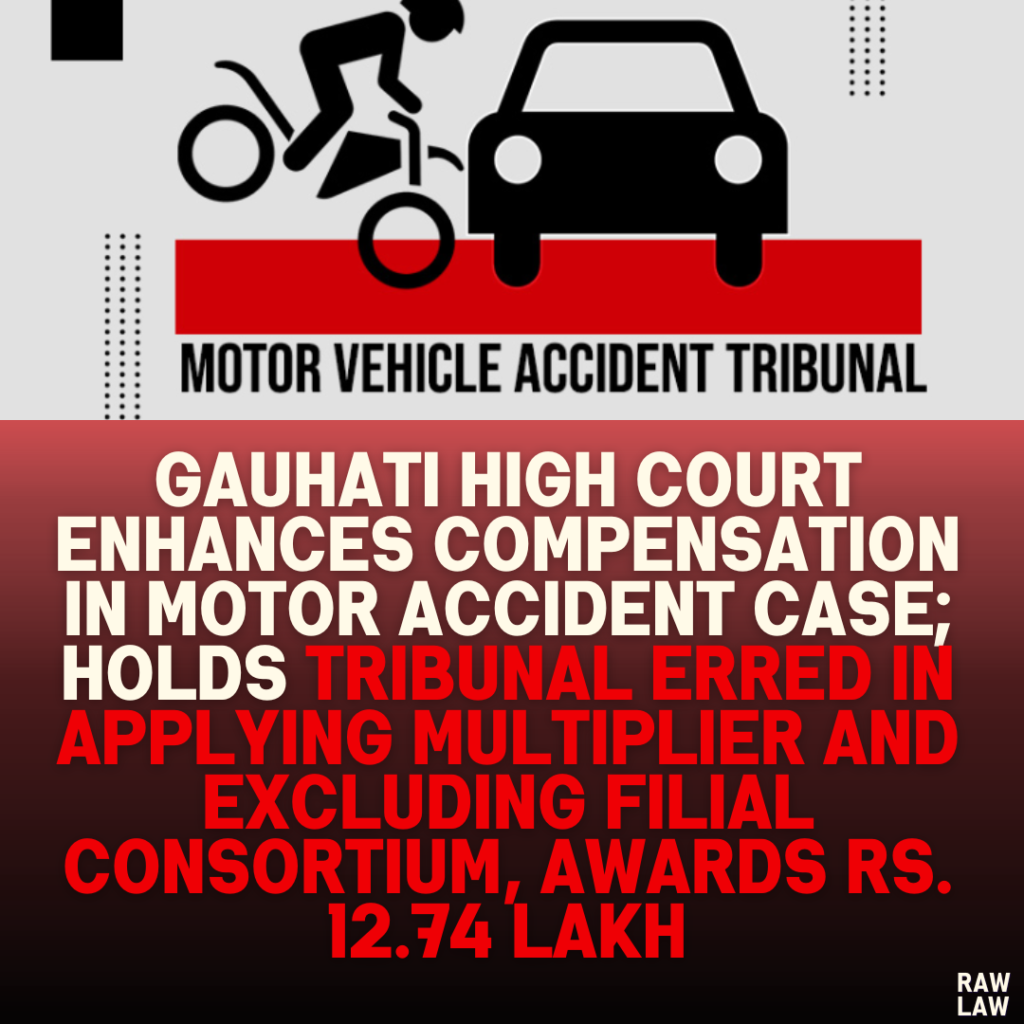Court’s Decision:
The Gauhati High Court modified the Motor Accident Claims Tribunal’s (MACT) earlier judgment by enhancing the compensation awarded to the appellants to Rs. 12,74,400 with 8% interest per annum. The Court held that the Tribunal erred in:
- Applying an incorrect multiplier by considering the age of the father instead of the deceased.
- Failing to account for future prospects at 40%.
- Omitting or inadequately calculating compensation under heads like filial consortium, loss of estate, and funeral expenses.
Facts:
- The case arose from a road accident on May 19, 2006, when the appellants’ 26-year-old son died due to injuries caused by a rashly driven pickup van.
- The appellants sought Rs. 9,00,000 in compensation, claiming the deceased earned Rs. 10,000–12,000 per month.
- The MACT awarded Rs. 2,85,000, based on an income of Rs. 8,000, while excluding certain compensatory heads such as filial consortium and loss of estate.
Issues:
- Was the Tribunal correct in applying a lower multiplier based on the father’s age instead of the deceased’s?
- Did the Tribunal correctly account for the deceased’s future prospects?
- Were compensation heads like filial consortium and funeral expenses properly addressed?
Petitioner’s Arguments:
- The Tribunal incorrectly applied a multiplier based on the claimant’s age, affecting the quantum of compensation.
- Future prospects at 40% of income should have been included per the Supreme Court’s Pranay Sethi guidelines.
- Compensation under filial consortium, loss of estate, and funeral expenses was either excluded or underestimated.
- Cited Joginder Singh v. ICICI Lombard General Insurance Co. and United India Insurance Co. v. Satinder Kaur, emphasizing comprehensive awards for loss of life and dependency.
Respondent’s Arguments:
- Acknowledged that the deceased’s age of 26 years was not properly factored into the calculations.
- Asserted that the income of Rs. 8,000 and the interest rate of 8% per annum were just and reasonable.
- Did not object to the inclusion of future prospects but argued that it should not carry additional interest.
Analysis of the Law:
The Court analyzed the following legal principles and precedents:
- Multiplier Selection:
- The Supreme Court in Pranay Sethi mandates that the deceased’s age is the determining factor for choosing a multiplier. For a 26-year-old, the correct multiplier is 17.
- Future Prospects:
- Future prospects should be calculated as 40% of the deceased’s income for individuals under 40 years of age. This was not properly considered by the Tribunal.
- Heads of Compensation:
- The Supreme Court in Satinder Kaur recognized the need to account for filial consortium, loss of estate, and funeral expenses. The Tribunal’s award excluded or inadequately calculated these amounts.
- Deductions for Personal Expenses:
- As the deceased was unmarried, 50% of the income should have been deducted for personal expenses, consistent with established norms.
Precedent Analysis:
- Joginder Singh v. ICICI Lombard General Insurance Co.: Clarified the structured approach for awarding compensation under heads such as income, future prospects, personal expenses, and consortium.
- United India Insurance Co. v. Satinder Kaur: Highlighted the importance of filial consortium in compensation calculations and provided a multiplier table for reference.
- Pranay Sethi Case: Set the standard for calculating future prospects, multiplier application, and other aspects of compensation.
Court’s Reasoning:
- Multiplier Error: The Tribunal wrongly applied the multiplier based on the father’s age instead of the deceased’s. The Court corrected this to a multiplier of 17 for the deceased’s age of 26.
- Future Prospects: The Tribunal failed to include future prospects, which the Court rectified by adding 40% of the deceased’s income (Rs. 3,200).
- Filial Consortium and Other Heads: The Court held that the claimants were entitled to Rs. 96,000 for filial consortium, Rs. 18,000 for loss of estate, and Rs. 18,000 for funeral expenses.
- Agreement Between Parties: Both parties agreed to an enhanced award and recalculated compensation under mutually agreed terms.
Conclusion:
The Court modified the compensation to Rs. 12,74,400, comprising:
- Loss of future income: Rs. 11,42,400 (Rs. 8,000 – 50% deduction + 40% future prospects x 12 months x multiplier 17).
- Filial consortium: Rs. 96,000
- Loss of estate: Rs. 18,000
- Funeral expenses: Rs. 18,000
The Court also directed that:
- Future prospects (Rs. 3,36,400) would not attract interest.
- Previously paid amounts would not attract interest and be adjusted against the total compensation.
- The insurer must pay the enhanced compensation within 60 days.
Implications:
This judgment emphasizes the judiciary’s commitment to ensuring justice in motor accident cases by strictly adhering to legal precedents and principles. It serves as a reminder to Tribunals to meticulously apply the correct multiplier, consider future prospects, and include all relevant compensation heads to avoid unfair reductions in awards.




Pingback: Bombay High Court Dismisses Appeal Over Fraudulent CENVAT Credit Claims of ₹5.63 Crore, Holds Reversal Cannot Rectify Fraudulent Modus Operandi and Extended Limitation Is Justified - Raw Law